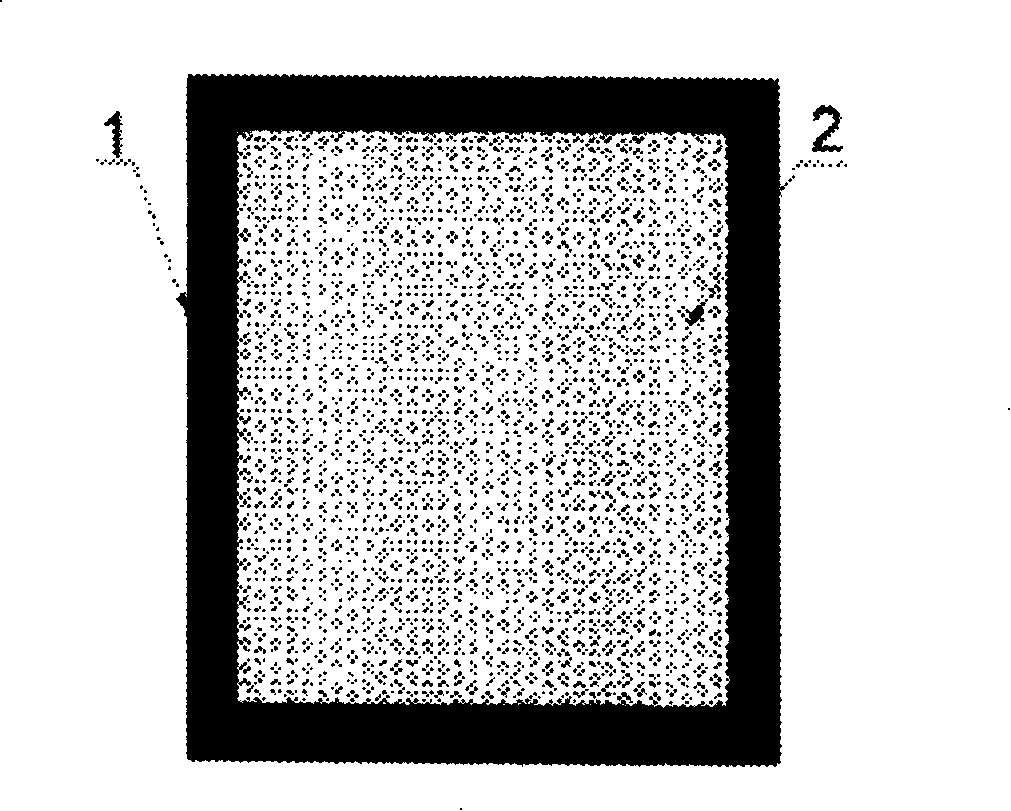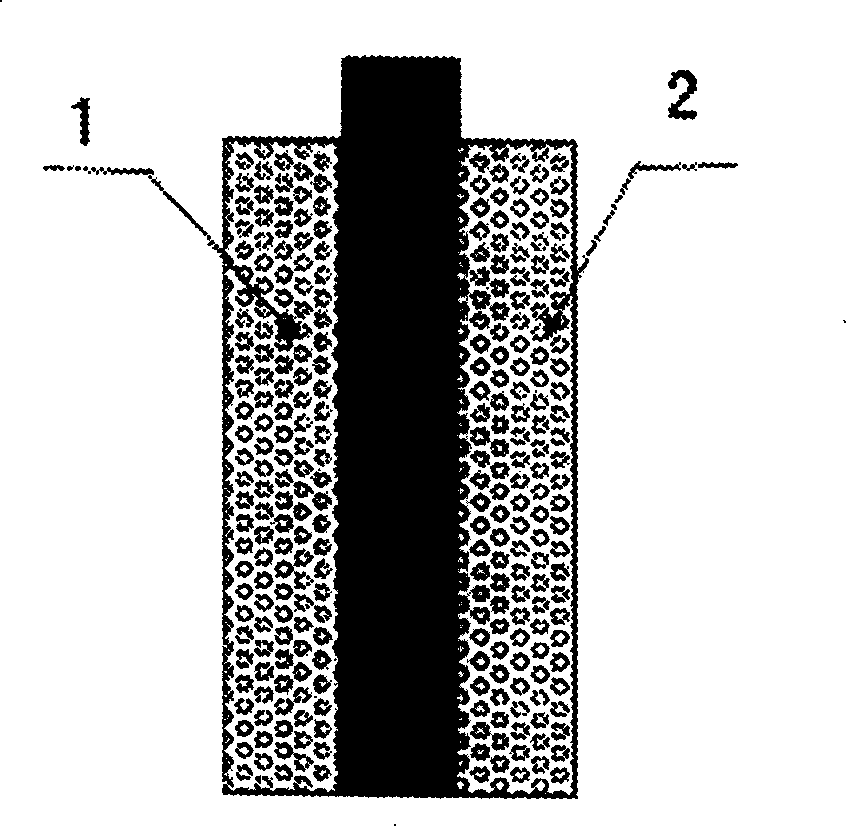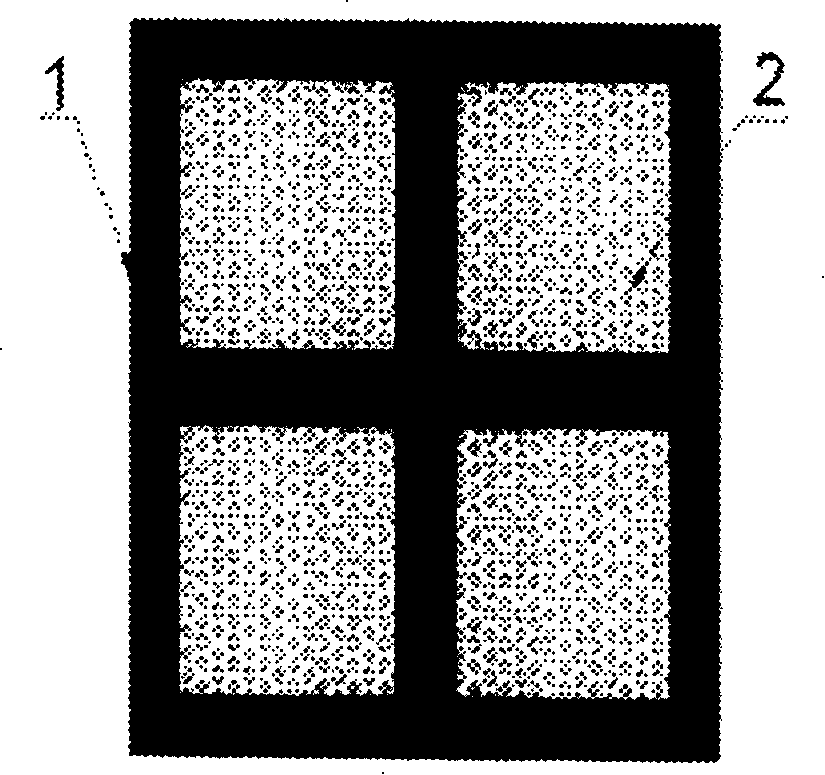Energy-saving anode for non-ferrous metal electrodeposition
A non-ferrous metal, electrowinning technology, applied in electrodes, electrolysis process, electrolysis components, etc., can solve the problems of serious lead pollution, high energy consumption, high anode oxygen evolution overpotential in cathode products, and achieve lower real current density, preparation Low cost and the effect of reducing oxygen evolution overpotential
- Summary
- Abstract
- Description
- Claims
- Application Information
AI Technical Summary
Problems solved by technology
Method used
Image
Examples
Embodiment 1
[0013] Such as figure 1 As shown, when a frame structure is used as a copper electrowinning anode, the conductive metal substrate is pure Pb with a thickness of 1mm; the porous metal layer is a Pb-Ca-Sn alloy with a thickness of 0.5mm, a porosity of 10%, and a pore diameter of 0.1-0.2mm, the Ca content is 0.12wt.%, and the Sn content is 1wt.%. The conductive metal substrate is metallurgically bonded to the porous metal layer to eliminate contact resistance. The anode of this structure is combined with the stainless steel cathode, and the composition of the electrolyte is 120g / L H 2 SO 4 , 45g / L Cu 2+ , the temperature is 25±0.5℃, the current density is 250A / m 2 When electrolyzing under the same conditions, the oxygen evolution overpotential of the anode is 600mv, which is about 60mV lower than the oxygen evolution overpotential of the Pb-based alloy anode currently used in industry.
Embodiment 2
[0015] Such as figure 2 As shown, when a sandwich structure is used as a zinc electrodeposition anode, the conductive metal substrate is a Pb-Ag alloy with a thickness of 3mm and an Ag content of 0.3wt.%; the porous metal layers on both sides are Pb-Ag-Ca-Sr The elemental alloy has a thickness of 2mm, a porosity of 50%, a pore diameter of 0.7-0.9mm, and contents of Ag, Ca, and Sr of 0.3wt.%, 0.03wt.%, and 0.03wt.%, respectively. The conductive metal substrate is metallurgically combined with the porous metal layers on both sides to eliminate contact resistance. The anode of this structure is combined with the aluminum cathode, and the composition of the electrolyte is 160g / L H 2 SO 4 , 60g / L Zn 2+ , the temperature is 35±0.5℃, the current density is 500A / m 2 During electrolysis under the same conditions, the oxygen evolution overpotential of the anode is 860mv, which is about 90mV lower than the oxygen evolution overpotential of the Pb-based alloy anode currently used in ...
Embodiment 3
[0017] Such as image 3 As shown, when the grid structure is used as a manganese electrowinning anode, the metal conductive plate is a Pb-Sn alloy with a thickness of 6mm and a Sn content of 40wt.%; the porous metal layer is a Pb-Sb-Sn-Ag quaternary alloy , the thickness is 8mm, the porosity is 80%, the pore diameter is 4.1-4.2mm, and the contents of Sb, Sn and Ag are respectively 1wt.%, 38wt.%, 0.8wt.%. The conductive metal substrate is metallurgically bonded to the porous metal layer to eliminate contact resistance. The anode of this structure is combined with the titanium cathode, and the composition of the electrolyte is 120g / L (NH 4 ) 2 SO 4 , 17g / L Mn 2+ , the pH value is 7, the temperature is 40°C, and the current density is 800A / m 2 During electrolysis under the same conditions, the oxygen evolution overpotential of the anode is 980mv, which is about 100mV lower than the oxygen evolution overpotential of the Pb-based alloy anode currently used in industry.
PUM
| Property | Measurement | Unit |
|---|---|---|
| thickness | aaaaa | aaaaa |
| thickness | aaaaa | aaaaa |
| pore size | aaaaa | aaaaa |
Abstract
Description
Claims
Application Information
 Login to View More
Login to View More - R&D
- Intellectual Property
- Life Sciences
- Materials
- Tech Scout
- Unparalleled Data Quality
- Higher Quality Content
- 60% Fewer Hallucinations
Browse by: Latest US Patents, China's latest patents, Technical Efficacy Thesaurus, Application Domain, Technology Topic, Popular Technical Reports.
© 2025 PatSnap. All rights reserved.Legal|Privacy policy|Modern Slavery Act Transparency Statement|Sitemap|About US| Contact US: help@patsnap.com



